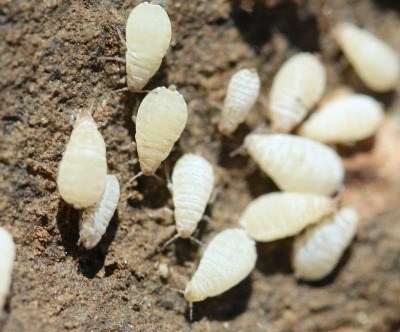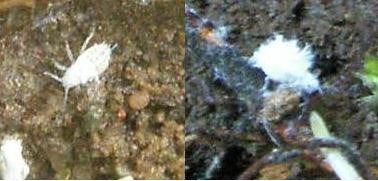Critters Down Under: Root Aphids


Most growers have experienced aphid outbreaks in their crops. Often, they are found on the young, new growth of many types of plants. However, some aphids grow and feed from the root system of several plant species and are classified as root aphids. These aphids are not the same as those that feed from the upper parts of the plants.
Life cycle
There are several species of root aphids, most of which are Pemphigus species (Table 1). Each species feeds on a limited number of plant species, but some have a wider plant host range. Root aphids vary in color, but most are white, whitish yellow or brown. Adults look somewhat like aphids you find on new stems and leaves, except most are pear-shaped and have shorter antennae and legs. Most root aphids have cornicles, or “tail pipes”, protruding from the end of the abdomen, like their aboveground counterparts.
Like all aphids, they have piercing, sucking mouthparts that extract sugar-rich sap from underground structures such as roots, bulbs and rhizomes. Root aphids produce a white, waxy secretion later in their lifecycle that covers them, and some is left behind as they move through the growing medium. This is often mistaken for mealybugs that are also covered with a white waxy or threadlike substance. It is best to use a hand lens and observe the roots to see the actual insect.

Root aphids give birth to nymphs that tend to cluster in a concentrated area on the root system. These wingless “crawlers” do not move as quickly as their aboveground counterparts but can still spread from container to container through the drainage holes: they can either crawl from pot to pot or be carried by irrigation water. They can also be transferred in growing medium debris or on equipment.
During the fall, especially outside where soil temperatures decline, winged adults appear from the soil and lay eggs on the stems and residues, so their populations can begin again in the spring. In the greenhouse, winged root aphids are not as common, but can emerge if the populations become too high in the container they are infecting. Winged adults can crawl up the stems of plants and can be confused with aphids that only affect leaves and tender tissue. Their lifecycle is much shorter when growing medium temperatures are warm, so their numbers can quickly explode during the heat of late spring and summer.

| Common Name | Scientific Name | Crops Infested |
|---|---|---|
| Root Aphid | Pemphigus sp | Aster, basil, boltonia, coreopsis, flowering, cabbage, gaillardia, hosta, kale, lettuce, oregano, sudum, sempervivum, veronica |
| Rice Root Aphid | Rhopalosiphum rufiabdominale | Barley, cotton, dieffenbachia, eggplant, oats, potato, rice, tobacco, tomato, wheat |
| Mint Aphid | Ovatus crataegarius | Mint |
| Tulip Bulb Aphid | Dysaphis tulipae | Crocus, iris, tulip |
Plant Damage
Minor infections of root aphids do not cause significant plant damage. However, as the populations increase, wounds in plant roots can become entry points for root disease pathogens, especially if plants are under stress. Plant roots cannot take up nutrients and therefore can exhibit nutrient deficiencies in the leaves. Plants often have a lack of vigor, are smaller and can wilt, especially during the heat of the day.
Root aphids do not travel rapidly, so infections are often restricted to a few plants and spread slowly initially. It is best to check plants that are showing symptoms. If you see the white powdery or waxy substance left on the outside of the root ball, then it is most likely root aphids. Keep in mind that the waxy white substance looks very much like the same deposits on mealybugs, so examine the roots with a hand lens as both insects look very different. Also, the white waxy material sometimes has white strands that look like fungal growth. Again, look at the growth with a hand lens or send a plant off to a diagnostic lab for confirmation.
Presence in Growing Media?
Some sources claim that root aphids can come from growing media. Root aphids indeed spend the majority or all their life cycle in mineral soil, but they are not typically found in peat moss as the plant material that grows on the bog is aquatic to semiaquatic, which root aphids cannot tolerate. Bark and coir are found aboveground, and perlite and vermiculite are heated to 1800 °F (1000 °C), making it impossible for root aphids to survive. Reusing growing media that are contaminated with root aphids or making growing media from unsanitary components or mineral soil could introduce a root aphid problem.
Cultural Controls:
- Avoid keeping stock plants or “pet plants” in the greenhouse where populations of root aphids could stay year-round.
- Avoid reusing pots where root aphids could be transferred to a new crop.
- Pull weeds from under benches that can also harbor root aphid populations.
- Minimize plant stress (under / overwatering, improper nutrition, etc.) to help reduce susceptibility to root aphid attacks.
- Root aphids thrive in dry conditions, so keep growing media moist to wet.
- If available, use root aphid-resistant plant varieties.
Root aphids are difficult to control with insecticides as the active ingredients can be tied up in organic components such as peat moss and bark, and most systemic insecticides accumulate in the upper portions of the plant. When applying an insecticide drench, make sure the growing medium is thoroughly drenched as root aphids tend to be found on the outside and bottom of the root ball. Also, the waxy secretions serve as a protective barrier from insecticides. Biological controls are beneficial, but some sources have found limited success with them.
The best way to control root aphids is to periodically pull susceptible plants from pots and examine plant roots for root aphids or white, waxy secretions. If some of your plants have root aphids, then it is best to discard them. Although root aphids are not that common in greenhouse crops, remember that if you see plants exhibiting nutrient deficiencies, examine the roots for root aphids in addition to root diseases.